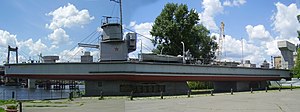Soviet monitor Zhelezniakov
This article needs additional citations for verification. (January 2024) |
 | |
| History | |
|---|---|
| Name | Zhelezniakov |
| Laid down | November 1934 |
| Launched | 22 November 1935 |
| Completed | October 1936 |
| Fate | Converted to a hulk, 11 March 1958 |
| Status | Museum ship since 10 July 1967 |
| General characteristics | |
| Type | Monitor |
| Tonnage | 263 tonnes (259 long tons; 290 short tons) |
| Length | 51.2 metres (168 ft) |
| Beam | 8.2 metres (27 ft) |
| Draft | .9 metres (2 ft 11 in) |
| Propulsion | 4 diesels (280 hp), 2 screws |
| Speed | 8.3 kn (15 km/h; 10 mph) |
| Endurance | 3,700 nautical miles |
| Crew | 78 |
| Armament |
|
| Armor |
|
Zhelezniakov is a river monitor of the Soviet Navy (Project SB-37), the lead ship of its class of six ships. Completed during the 1930s it participated in World War II and was the only one of its class that survived the war.[1]
The ship was named after the Russian sailor Anatoli Zhelezniakov who was famous for being among those who dispersed the Russian Constituent Assembly in 1918 and his saying "The guard has grown weary".
In 1967 it was installed in the Sailor's Park at Rybalskyi island as a monument-memorial. The same year around the monument was created the Sailor's Park (official name "To the sailor's of the Dnieper Flotilla"). The ship is a landmark of science and technology, history with a protected number 260062-N.
Citations
[edit]- ^ Budzbon, Radziemski and Twardowski, pp. 210–211
Bibliography
[edit]- Budzbon, Przemysław; Radziemski, Jan & Twardowski, Marek (2022). Warships of the Soviet Fleets 1939–1945. Vol. I: Major Combatants. Annapolis, Maryland: Naval Institute Press. ISBN 978-1-68247-877-6.
50°28′26″N 30°31′32″E / 50.47395°N 30.52567°E


 French
French Deutsch
Deutsch